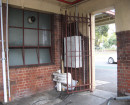Back to search results
UNITED GLEESON'S MINE & BATTERY
SAILOR BILL TRACK KEVINGTON, MANSFIELD SHIRE
UNITED GLEESON'S MINE & BATTERY
SAILOR BILL TRACK KEVINGTON, MANSFIELD SHIRE
All information on this page is maintained by Heritage Victoria.
Click below for their website and contact details.
Victorian Heritage Inventory
-
Add to tour
You must log in to do that.
-
Share
-
Shortlist place
You must log in to do that.
- Download report
On this page:
Statement of Significance
This record has minimal details. Please look to the right-hand-side bar for any further details about this record.
Show more
Show less
-
-
UNITED GLEESON'S MINE & BATTERY - History
Heritage Inventory History of Site:
The United Gleeson's mining area covers the site of numerous mining operations dating back to 1864. The Hungarian GMC, in 1865, erected a 15-head water-powered battery at their mine on Sailor's Creek. (Lloyd says that a 5-head battery was initially erected, which was enlarged to 20-head in 1866, at which time the waterwheel was replaced by a steam engine.) At the same time, the Hungarian Co. constructed a system of level and inclined tramways and two short water races. One of the tramways, near-vertical, with a grade of 6-in-7, was probably (according to Milner) the steepest ever constructed in Victoria and a considerable engineering achievement.
Gleeson's Co., on the same reef, first appeared in the records in 1866-7, when it achieved impressive yields, for example, 379 oz of gold from 80 tons of stone. In 1871, the mine was still/again recording 'splendid' yields, from both the 150-ft and 350-ft levels. A tramway was, at that time, constructed from the Gleeson's mine to 'an adjoining machine' (a 20-head battery, probably that of the Hungarian Co., which was still in operation) and stoping between levels commenced. The Gleeson's Co. worked the reef by tunnel: the main one was 600 ft in length, and a No. 3 (lower) tunnel had been commenced. In 1872, the company made 'some fresh arrangements with regard to machinery, presumably moving the battery closer to their mine, or installing their own battery, then kept up its 'high character' with more impressive crushings. Dividends for just one quarter in 1874 amounted to £3375.
Driving a low tunnel towards Gleeson's rich ground from the opposite direction was the Sailor Bill's Co. Its tunnel was begun in 1872, and it took 4½ years and more than £5,000 before crushing commenced. In 1877, the company erected a 10-head battery powered by a 40-ft waterwheel, at the junction of Sailor Bill's and Purdy's creeks, about 1,200 yards from the mouth of their tunnel.
Also driving tunnels on the Gleeson's/Sailor Bill's reef in the early 1870s were the North Gleeson's and Clancy's parties.
By 1877, the Gleeson's Lease Co. was scratching to find good stone. They repaired their battery and let the mine on tribute to 'a very good party of men'. The Sailor Bill's Co., which, between poor stone and no water for crushing, had achieved little, let their mine on tribute in 1878. In the same vicinity, the Clancy brothers got an occasional good crushing from their claim, and the Perseverance Co., driving for Gleeson's Reef, discovered the Wind-bag Reef in their tunnel. The Gleeson's lease tributers appear to have abandoned prospecting in 1882, after sinking a shaft intended to strike the Clancy's Reef.
The Sailor Bill's Co. added five more stampers and a steam engine to their plant in 1883, water being available for crushing during just three months of the year. Their tunnel was in a distance of 1,178 ft. The company pushed on with prospecting and development of the mine until 1887, without striking payable stone. Likewise, tributers were unable to find gold in the Gleeson's mine (sample crushings were carried out at the Sailor Bill's battery). In 1889, the Sailor Bill's and Gleeson's companies amalgamated.
The United Gleeson's and Sailor Bill's mine (generally known as the United Gleeson's) operated more or less continuously until 1928, using the old Sailor Bill's battery the whole time. Focusing on the Sailor Bill's workings, the mine was Jamieson's premier gold-producer from 1900-08, yielding 4952 oz during that period. In 1907, Dunn reported on the immense amount of work done in the past: a great mass of very rich quartz had been removed when the mine was first worked, leaving a cavity known as 'the Ballroom'.
When the Gleesons, Sailor Bill's amalgamation took place in 1889, working of the Clancy brothers' reef was again (still?) underway. That year, the Clancy party erected an 8-head battery powered by a 20ft-diameter pitch-back waterwheel. The Clancy's Reef GMC later operated the mine, from 1908-10, crushing with a 5-head battery.The United Gleeson's mine was re-opened in the late 1980s, with a new adit driven parallel to the old Hungarian adit, towards the Clancy brothers' mine workings.
References:
Department of Mines Annual Report, 1908-10
Dunn, p. 44Lloyd, p. 28;
Tables 2-4, 9-1, 15-1
Milner, pp. iv, 3
Mining Surveyors' Reports (Jamieson Division), June & December 1865, September & September 1866, December 1867, June & December 1871, March, December 1872, December 1874, September 1875, September & December 1876, June & December 1877, September 1878, March & June 1880, December 1881, June 1883, September 1887, December 1888, September 1889Heritage Inventory Description
UNITED GLEESON'S MINE & BATTERY - Heritage Inventory Description
United Gleeson's mining area - the only remains of the earlier operations are a few benched hut sites (one of them with a stone chimney), the benched area where the Clancy brothers' battery was located, some open stopes about 10-15 m above the level of the new adit, and the site of the winch for the flying fox that brought ore from the Windbag mine workings to the hopper for the Clancy brothers' battery./nSailor Bill's/United Gleeson's battery site - the site described by local historian Peter Poole as the United Gleeson's battery site is about 1 km east of the present (1989) United Gleeson's mine. The site occupies both sides of Sailor Bill's Creek and is very overgrown with blackberries. It consists of a number of benched building sites, a cutting in the bank above the creek where the waterwheel operated, a water-race, and some tramway formations. Updated June 2022- The workings in the Sailor Bills Creek area are numerous and extensive. Many quartz reef workings were developed from the 1860s and worked into the early 20th century. At least six batteries operated at different times. The landscape strongly reflects the mining history of the area, with vast mullock dumps, tracks, adits and cuttings. Only a small area of these workings was recorded. Clancy’s adit; is defined by a large mullock dump. The approach trench to the portal is wet and filled with tree-ferns and vegetation. The adit is open. No.1 Adit & Water Adit:. The road/track approaching these workings passes between two large and impressive dumping lines of blue slate and sandstone mullock. The approach trench to the No.1 adit is obscured by tree-ferns and vegetation. No.2 Adit (Horse); is found immediately above the No.1 Adit. The present 4WD track terminates on the level of the mullock dump. The approach trench to the adit is lined with tree-ferns. Adit is open. A level tramway extens around the hillside from the east side of the mullock dump. Clancy’s Shaft; is approached via an overgrown track from the eastern side of the No.2 Adit. The collar of the shaft is located within a cutting approximately 4 metres deep. The shaft is rectangular. Historic mining plans show the shaft to be over 40 metres deep. Immediately above Clancy’s Shaft cutting, workings continue up both gullies. A cursory inspection revealed numerous open adits and two shafts approximately 2 metres deep. Time constraints did not allow for survey and recording of these extensive workings.
-
-
-
-
-
UNITED GLEESON'S MINE & BATTERY
 Victorian Heritage Inventory
Victorian Heritage Inventory
-
-






